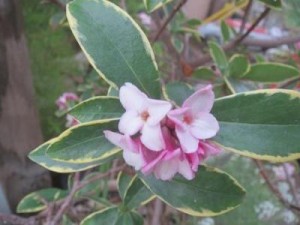Did I kill my Daphne odoro, my luscious, variegated daphne that has bloomed fragrantly every Valentine’s Day for years?
Hint to whoever loves me: a new Daphne odoro (preferably the kind with variegated leaves) would be a superb choice for a Christmas gift.

The tips of the latest turned black last spring, and I thought that was the end of an era. However, I remembered the advice of John Whittlesley of Canyon Creek Nursery. He said not to water the plant if the high temperature for the day would reach 89 degrees, (something about bacteria in the soil that goes berserk when watered in warm weather). I also put some good bacteria into the soil in the form of really good organic compost.
My Valentine’s Day bloomer survived but did not thrive.
Then I moved to a new house and could not leave this beloved plant behind. Daphne hate to be transplanted or repotted. Apparently they also don’t like to move to a new home.
Probably the final blow for the fussy plant was I used greywater saved from the kitchen sink.
Care with greywater
During the drought, I’ve had fun collecting a little water in my sink. When I rinse my hands or vegetables, sans soap, I let the water flow into a plastic container.
The water adds up, and I feel smug to be saving water that I would normally waste.
Does dish soap sometimes slop over into this grey water container? Probably.
Is that a problem? I didn’t think so.
A few weeks ago I was chatting with my new buddy Bob Scoville, a master gardener in Glenn County. (You can call the Glenn garden gurus 2-4 p.m. Wednesdays at 865-1110).
Bob shared some information on soaps and soil. Suds usually contain chemicals that can make soil alkaline.
For example, some people are setting up their washing machines so the water runs outdoors. Most laundry soaps contain sodium, potassium and calcium.
After time, the soil can become alkaline.
You can test soil after a year or more, then amend to bring things back in balance. I don’t know about you, but there are reasons why I do not have a master’s degree in soil chemistry.
At least for these times of drought, the easiest path is to avoid greywater for acid-loving plants. These also tend to be shade plants.
Here’s some plants that do NOT like greywater: rhododendrons, begonias, bleeding hearts, ferns, foxgloves, hydrangeas, oxalis, azaleas, violets, philodendrons, camellias, impatiens, primroses, crape myrtle, holly, redwoods, star, jasmine, deodar and cedar.
As for things that do well with greywater, many of these are things that seem to do well with no water at all: oleander, bougainvillea, Italian stone pine, oaks, palms, Arizona cypress, purple hopseed bush, olive rose, rosemary, Australian tea tree, juniper, ice plant, Bermuda grass, many native plants, agapanthus, cottonwood and honeysuckle.
I’ve been dumping greywater on some volunteer nandina, and these plants are thriving.
Another rule of thumb might be to avoid dumping grey water on plants you really care about. Annuals will die this winter, for example.
If the soil becomes too alkaline over time, you can neutralize the soil by adding more organic matter.
CLEANER GREYWATER
Another route to take is to avoid icky soaps in your daily life.
Butte County Master Gardener Kay Perkins simply shops for soap that does not contain phosphates.
This doesn’t mean you can use all your dish water in the yard. You still don’t want grease and meat pathogens in your soil outdoors.
Kay said she used Green Works, by Clorox, and buys it by the big jug at Cash and Carry. This works for laundry as well.
LOGICAL LINKS
While on this greywater path, I found a website with some very cool ideas for setting up a greywater system in your home: http://goo.gl/nFBJm9
